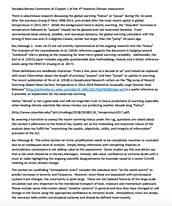Key Message 1: Lines 16–23 are not entirely representative of the ongoing research into the “hiatus”. The inclusion of the Lewandowsky et al. (2016) reference suggests this document is hedging toward “statistical” cherry-picking as the reasoning for short-term global warming variability. Additionally, the Karl et al. (2015) paper includes arguably questionable data methodology choices and a better reference exists using the ERSSTv5 (Huang et al. 2017).
Detailed Review Comments of Chapter 2 of the 4th National Climate Assessment
There is voluminous research discussing the global warming “hiatus” or “pause” during the 16-years after the previous strong El Nino 1998–2014, only ended after the most recent uptick in global temperature in 2015–2017. While the background trend is clearly warming, the “step-like” increases in temperature followed by “pauses” should not be glossed over but examined honestly. From conventional observational, satellite, and reanalysis datasets, the global warming coincident with the strong El Nino was over 0.2‑degrees Celsius, similar but larger than the “jump” 20-years ago.

This work is licensed under a Creative Commons Attribution-NonCommercial-ShareAlike 4.0 International License.

